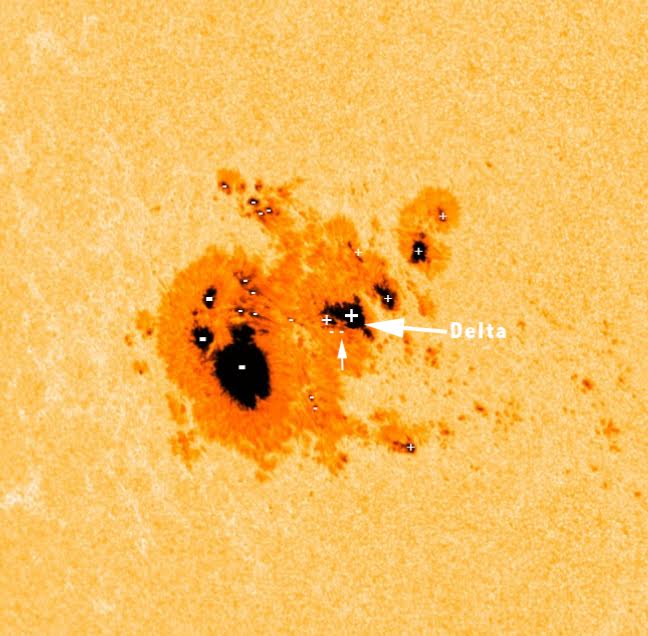Active aurora, sunspot region 2192
Monday, 20 October 2014 15:55 UTC

Sunspot region 2192 stays very active today with multiple C-class solar flares and an impulsive M3.19 (R1-moderate) solar flare at 09:11 UTC. There was no coronal mass ejection associated with the M3.1 solar flare due to the short duration of this event. How is this impressive sunspot group looking right now and what can we expect from it the coming days? We also take a look at the current geomagnetic conditions.
Evolution of sunspot region 2192
Multiple delta sunspots are observed within sunspot region 2192, including some new spots that have developed around the already strong delta spot in the northwestern section of the region. This zone of opposite polarity is slowly drifting away from the leading spots and in the penumbral zone. Between it there is a brighter part which may indicate that this zone separates itself from the leading spot group. But nevertheless just south of the main delta spots there is a line of small spots with negative polarity very close to the delta spots (positive polarity), if those tiny spots develop further, a magnetic inversion line might form which would create much tension between the two zones. If this growth continues, the chances for a strong X-class flare to occur will be raised considerably. New spots are also being formed in the northern part of sunspot region 2192 together with more penumbral growth. With the current magnetic layout, the chances for more M-class flares are high with an increasing chance for X-class flares as this sunspot region continues to development further. All the other sunspot regions on the disk are unremarkable. Any future solar flares will very likely be centered around sunspot region 2192 which is now rotating into a better earth-facing position.

Images: NASA SDO.
Solar flare odds for the coming 24 hours
M-class flare probability: 70% chance
X-class flare probability: 30% chance
Geomagnetic conditions
Geomagnetic conditions remain elevated thanks to continuing coronal hole effects. The direction of the IMF is mostly southward which is causing active (Kp4) geomagnetic conditions. Skywatchers in Scotland, most of Scandinavia, Finland and northern Russia should be alert for aurora this coming evening. Same goes for sky watchers near the US-Canadian border if the current conditions hold. In the past hours, aurora was already spotted from southern New Zealand. The image below was captured today by Chris Watson. He managed to make this stunning shot of the aurora australis together with the Milky Way.

Unsure what all of this means? Read our help articles!
Thank you for reading this article! Did you have any trouble with the technical terms used in this article? Our help section is the place to be where you can find in-depth articles, a FAQ and a list with common abbreviations. Still puzzled? Just post on our forum where we will help you the best we can!
Latest news
Latest forum messages
Support SpaceWeatherLive.com!
A lot of people come to SpaceWeatherLive to follow the Sun's activity or if there is aurora to be seen, but with more traffic comes higher server costs. Consider a donation if you enjoy SpaceWeatherLive so we can keep the website online!

Space weather facts
| Last X-flare | 2025/03/28 | X1.1 |
| Last M-flare | 2025/04/18 | M4.4 |
| Last geomagnetic storm | 2025/04/16 | Kp8- (G4) |
| Spotless days | |
|---|---|
| Last spotless day | 2022/06/08 |
| Monthly mean Sunspot Number | |
|---|---|
| March 2025 | 134.2 -20.4 |
| April 2025 | 120.1 -14.1 |
| Last 30 days | 116.4 -25.9 |



